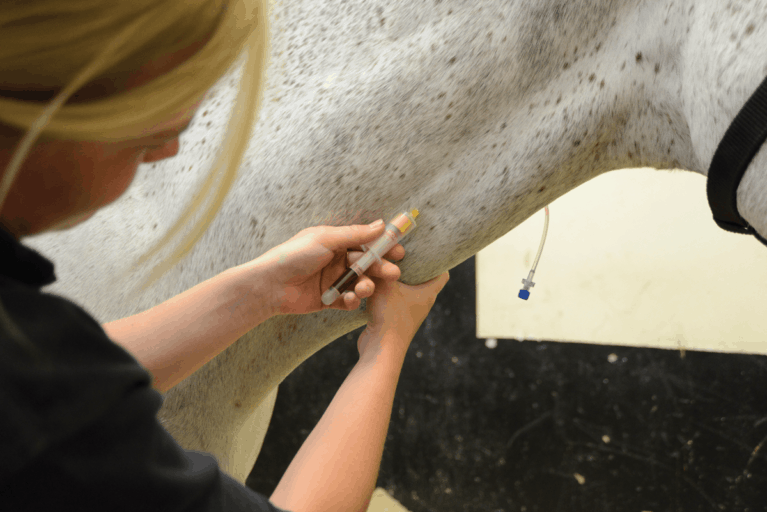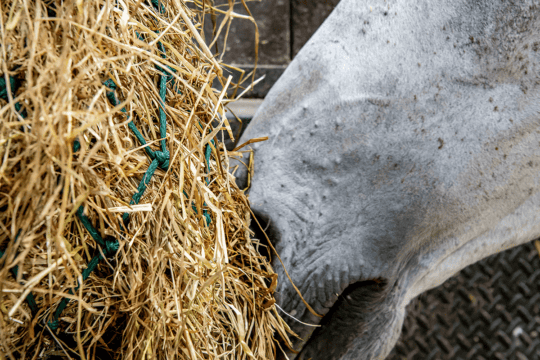Has your horse had his flu vaccination? Vet Katherine Murray explains more about this incredibly contagious disease and why vaccination is so important

Has your horse had his flu vaccination? Vet Katherine Murray explains more about this incredibly contagious disease and why vaccination is so important
Many of us have our horses vaccinated against flu every year, but there are some circumstances where owners wonder whether their horse really needs vaccinating – for example, if he’s retired and never leaves the yard. However, if flu strikes, it can spread like wildfire, not only making horses sick, but also having a huge impact on the equine industry as a whole.
If your horse were to catch flu, it could make him very poorly and take him up to six months to recover, plus it leaves him open to developing nasty secondary infections that could extend his recovery time dramatically, so ensuring all horses are vaccinated against this devastating disease is of the utmost importance.
What is equine flu?
Equine influenza (flu) is a highly contagious, infectious respiratory disease. It’s caused by a virus that’s inhaled via the nostrils, where it invades the lining of the upper airway. This causes inflammation of the upper airway, which consists of the larynx (voice box), trachea (windpipe) and the bronchi (passageways into the lungs).
The virus destroys the cells that make up the lining of the airway, which reduces the ability of the airway to clear mucus and debris. Bacteria then has the chance to multiply and invade the tissue, causing secondary infections.
Why outbreaks can be devastating
Flu is found in countries all over the world, excluding Iceland, New Zealand and Australia (since 2007). It’s endemic to the UK equine population, which means it’s constantly present.
Outbreaks of the disease occur rapidly and can have a devastating effect on the equine population. For example, in 2007 there was a huge outbreak of equine flu in Australia, where the disease had never occurred before. The horses in this population were unvaccinated and, therefore, had no protection against the virus as their immune system had never encountered it before. At the peak of the outbreak, almost 50,000 horses were infected on nearly 6,000 different properties. It was estimated to have cost the industry hundreds of millions of dollars, mostly due to lost revenue from gambling and stallion fees when movement restrictions were in place. This shows just how devastating an outbreak of equine flu can be.
Quick to spread
The virus lives in the upper respiratory tract, so it’s spread by breathing, coughing and sneezing. Large numbers of horses kept in close contact allow rapid spread of the disease. It can also be passed from horse to horse by handlers, vets and yard equipment, so good hygiene is very important for preventing disease outbreaks. The virus doesn’t live for long outside the horse, as it can’t survive in the environment.
The incubation period of the disease is only 1–3 days – this is the time between exposure to the virus and the first appearance of clinical signs. This short incubation period is what facilitates the rapid spread of the virus between individuals, because the sooner the clinical signs appear, the sooner affected horses can pass it on to others.
Who is most susceptible?
Flu affects all equids, including donkeys and horses, but some horses are more susceptible to developing the disease than others. These include…
- unvaccinated or irregularly vaccinated horses
- young horses
- horses with a compromised immune system – for example, older horses and those suffering from other diseases such as PPID (Cushing’s disease) and RAO (recurrent airway obstruction)
- horses under increased stress, such as those travelling, competing or living in large groups
Signs of infection
How horses are affected by the infection depends on the immune state of each individual – for example, whether they’re young or old, vaccinated or unvaccinated. The clinical signs can range from so mild that they go unnoticed to very severe, although fatalities are rare and usually only occur in very young or old horses with weakened immune systems. The onset of clinical signs is very quick and they include…
- fever temperatures can reach more than 41°C. Viral infections (such as flu)often cause a higher temperature than bacterial infections
- enlarged lymph nodes just behind the jaw where the head and neck meet (enlargement indicates local infection, because these lymph nodes drain inflammatory cells from the head and help to fight infection)
- coughing dry and harsh with nothing being coughed up. This may last for several weeks, even in mild to moderate cases
- nasal discharge that’s clear or thin and white
- depression and weakness which may be noted as poor performance if it’s mild
- loss of appetite
The cells that line the airway take at least 21 days to regenerate, so full recovery may be seen after three weeks in mildly affected cases. However, severely affected horses may take up to six months to recover fully.
Potential complications
While the airway lining is regenerating, the remaining cells are susceptible to secondary bacterial infection. If this happens, the nasal discharge will become thicker with a green or yellow tinge, which is known as mucopurulent (containing a mixture of mucus and pus). The cough may also become wet with mucus being coughed up. Secondary bacterial infection may lead to severe pneumonia, which can lead to death if left untreated.
Other complications can be caused by the spread of bacteria from the lungs to other parts of the body via the bloodstream. An infection may be established in the heart muscle (myocardiditis), skeletal muscles (myositis) or the blood vessels themselves (vasculitis).
Vet visit
You know your horse best, so you will know when he’s not his normal self, but it’s advisable to call your vet if your horse shows any signs of respiratory disease, including coughing, sneezing and exercise intolerance. The sooner any problem is diagnosed and treated, the better the chance of a full and speedy recovery. With equine flu, it’s important that it’s diagnosed promptly, so that strategies can be put in place to prevent the spread of this contagious disease to other horses.
The clinical signs and a history of a rapidly spreading infection is enough for your vet to presume a diagnosis of equine flu. For a definitive diagnosis, your vet will need to take nasopharyngeal swabs from inside your horse’s nostril soon after he gets the disease. Alternatively, two blood samples can be taken two weeks apart to identify a rising level of antibodies in the blood.
Treatment options
Rest and supportive care are the basis of treatment in simple cases. As a guide, for every day your horse had a raised temperature, he should have at least one week of rest, including a minimum period of three weeks. This will allow enough time for a full recovery and prevent further damage to the respiratory tract, which could lead to secondary infections. Once your horse is fully recovered, you can bring him back into work slowly, but it’s important to monitor him closely for any signs of disease recurrence.
Anti-inflammatory drugs such as bute may be needed if your horse has a very high temperature of more than 40°C. Your vet may choose to administer this by intravenous injection into the jugular vein in your horse’s neck, then follow up with powder given in his feed. Drugs that aid breathing may also be helpful, as they dilate the airway, allowing increased airflow into the lungs. Antibiotics are sometimes administered in complicated cases where a secondary bacterial infection has occurred.
While your horse is recovering, it’s advisable to…
- restrict exercise
- reduce dust in the environment – use dust-free bedding and give soaked hay or haylage
- improve ventilation
- implement hygiene measures and isolate affected horses to reduce spread of the virus to others
If he’s given the appropriate treatment and allowed adequate time to heal, your horse should recover fully. The prognosis for equine flu is good if there are no complications.
In the event of an outbreak
As well as treating the individual horse for equine flu, it’s important to follow the guidelines below to limit the spread…
- isolate affected horses as soon as possible
- monitor in-contact and near-by horses for signs of
the disease - isolate any new cases immediately
- stop the movement of horses, even those not showing clinical signs, on and off affected yards until the outbreak is over to stop further spread of the disease
- during an outbreak, it may be helpful to give booster vaccinations to horses in the surrounding area who have not received a vaccination in the last six months.
Top tip
Isolate all horses who are new to the yard for at least two weeks to reduce the chance of exposing the rest of the yard to the virus, should the new horses be carrying it.
Vital vaccination
Vaccination is by far the best way to protect your horse against flu. It not only protects him, but also the population of horses across the UK via herd immunity. Herd immunity occurs when vaccination of a significant proportion of a herd provides a level of protection for individuals who haven’t been exposed to the virus. This is because there are fewer individuals that can be infected, so the disease dies out quickly.
Horses who are vaccinated can still get infected with the flu virus and have the potential to pass it on to unvaccinated horses. Therefore, it’s advisable to vaccinate all horses against influenza, including companion ponies and older horses, even if they never leave the yard.
How the vaccination works
Equine flu vaccinations contain an inactivated virus, which tricks the immune system into believing it’s being attacked, so the body creates an immune response. If a natural infection with equine flu occurs, the immune system is then primed ready to produce a faster and greater response. The vaccinated horse may still become infected with flu, but will show very mild clinical signs and produce lower levels of the virus, thus reducing the spread of disease.
There are several different brands of flu vaccine that are administered into the muscle and the vaccinations are recorded in your horse’s passport. The duration of protection these vaccines provide is fairly short-lived and the standard course of flu vaccines consists of three initial vaccinations, followed by a yearly booster…
- 1st vaccination – day 0
- 2nd vaccination – 21–92 days after the 1st
- 3rd vaccination – 150–215 days after the 2nd
- booster vaccinations must be given within 365 days of the 3rd vaccine in order to compete
There are some situations where extra rules apply…
- racehorses should not have received their last vaccination in the seven days prior to racing
- horses competing under FEI rules have to be vaccinated less than six months and 21 days before a competition
- pregnant mares should be vaccinated 4–6 weeks before foaling, so that antibodies will be passed on to foals in the milk
- foals may be vaccinated from six months of age
When viruses replicate, they can change slightly over time which creates new strains. Therefore, vaccines need to be regularly updated to contain the strains of virus that are currently active in the UK.
Don’t leave it to chance
There are around one million horses in the UK and recent figures suggest that only 50% of these are vaccinated. To achieve herd immunity against equine flu, at least 75% of the national herd needs to be vaccinated. So don’t fall into the trap of thinking that your horse doesn’t need to be vaccinated – get him booked in, not only to protect him, but his equine friends, too.















